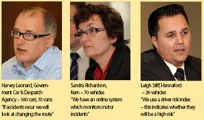Fleets are taking action to address safety concerns but need more support from management.
One-in-three road accidents involve someone who was driving for work; 20 at-work drivers die every week in a vehicle accident, 250 are seriously injured; the annual cost to employers of accidents is £3.7 billion.
With those facts in mind, plus the duty-of-care responsibilities under the Health & Safety At Work Offences Act and Corporate Manslaughter Act, it’s no wonder that fleet operators are putting increasing emphasis on safety.
However, not all senior management are bought into the idea of robust safety policies, according to fleets who attended the Fleet News Roundtable in association with Trimble.
Recent legislation introduced had made little difference to their views.Many supported risk management before the new laws came in but others remain unconcerned.
As Hilton Triesman, fleet director, Lewis Day Transport, says: “It has to come from the top, at director level. Fortunately our directors are very supportive.”
In spite of the hurdles, all the fleets said they were addressing the need t
o reduce accidents, train drivers, adopt new vehicle technology and tackle grey fleet issues.
The biggest issue to address is one of culture. “There’s a cultural problem with many drivers – they watch Top Gear and they think they are an expert,” says Bill Brewster, fleet manager, East Sussex Fire & Rescue Service.
“A lot of accidents we attend are down to speeding and that is increasingly on non motorway and non A-roads.”
Helphire fleet services director Tim Bailey believes the driving test needs to be more stringent. He points to the German process as a good template.
“People have to sign up to a minimum time that includes autobahn driving, night driving and driving in the rain,” Bailey says.
“The UK is far behind – we have to push for a better driving test and better training.”
Training is one way to influence a change in culture, although firms have to ensure the effects are long-lasting.
“One way to reinforce training is to draw their attention to the key messages every couple of months,” says Peter Bonney, Salvation Army fleet controller.
Andy Yeoman, Trimble managing director, advocates peer pressure via a league table of performers. He suggests focusing on fuel efficiency as a less emotive of way of getting the message across as “this relates to speed and driving performance”.
Yeoman adds: “If you reduce your fuel bill you could offer to share some of the savings with staff, weighting the amount to their position in the league table.”
Triesman is considering a policy at Lewis Day whereby the driver pays the excess – possibly even the cost of the whole repair – in an at-fault accident.
“That might be a deterrent,” he says. “Accidents will reduce because people are being more careful.”
However, companies need to also take responsibility by not asking too much of their drivers. Bailey believes some put too much pressure on drivers to get from one job to the next.
“You have to minimise downtime, improve route management and work with drivers and management to get from A to B in the right time and as safely as possible,” he says. “It often needs a culture change.”
The Government Car & Despatch Agency has set up an accident panel to discuss accident trends, including assessing whether an issue is due to a particular driver or a route.
“If speeding or accidents re-occur on a route we will consider changing that route or reducing the number of drivers that use it,” says communications manager Harvey Leonard.
Leigh Stiff, fleet manager at Hannover, ensures staff are fully familiar with a vehicle before they drive it. He also uses a driver risk index to analyse a driver’s propensity to speed.
Questions include ‘what car would you like to drive’ and ‘would you like to drive on an open road with no speed limits’. “The answers indicate whether someone is high risk,” Stiff says.
Yeoman advises fleets to identify the people that are most likely to have an accident by the behaviour they display and then focus on training them.
“You can pinpoint the issues and train appropriately,” he says.
Kern set up a web system last June which requires staff to record every motor incident.
Sandra Richardson, finance manager, says she can now take speedy action, particularly if a third party is involved, “rather than first hearing about it via the insurance company”.
Andrew Terry, fleet manager, Kent Fire & Rescue Service, puts the onus on the driver for unreported damage on end-of-lease cars. “The driver has a choice: make the accident claim or we send the car back to the leasing company and the bill will be passed onto them,” Terry says. “Word gets around – it’s a wake up call.”
Fleet vehicles targeted by fraudsters
Accidents caused by fraudsters looking to rip off insurance companies are becoming prevalent, according to some fleet managers.
Hilton Triesman says they are targeting vehicles they know to be insured, which puts company-branded vehicles at greater risk.
Tim Bailey adds: "They are using advanced tactics like two cars where one swerves in front of your car forcing you to brake and cause an accident. You have to work with the insurance company to make sure as much information is provided as possible."
Triesman pointed out that drivers still have to accept some responsibility. "If you go into the back of someone, in law it’s your fault," he says.



Special Report: Directors slow to increase their focus on duty of care
- 25 March 2010




















Login to comment
Comments
No comments have been made yet.